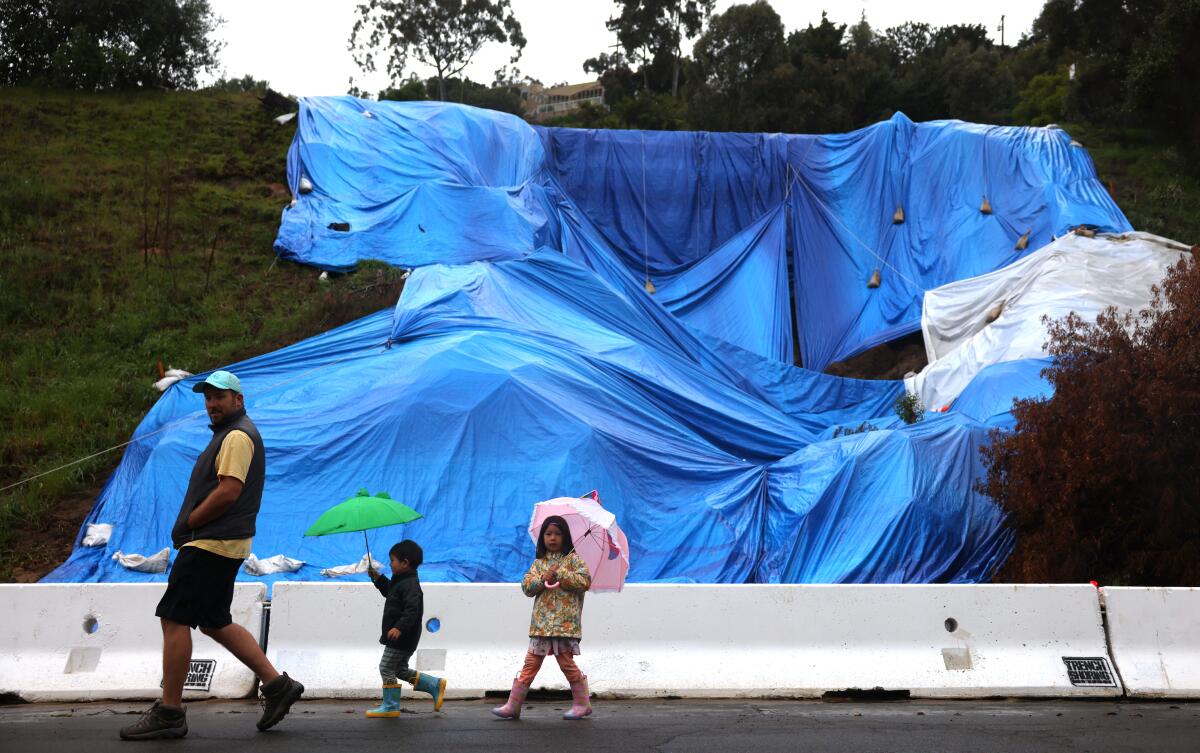Newsletter: After 50 years, Skid Row may be changing forever

- Share via
Good morning, and welcome to the Essential California newsletter. It’s Sunday, March 31. I am Liam Dillon, and I cover housing affordability. Here’s what you need to know to start your weekend:
- Three developments that could change Skid Row forever.
- Easter weekend storm slams Southern California.
- Officials ruled the death of a teen an accident after a school fight. What comes next?
- And here’s today’s e-newspaper.
Sign up for Essential California
The most important California stories and recommendations in your inbox every morning.
You may occasionally receive promotional content from the Los Angeles Times.
Skid Row is the homelessness capital of America. It’s going to look different very soon.
No area is as synonymous with the nation’s homelessness crisis as Skid Row in Los Angeles. Now, the area is approaching a moment of generational-defining change.
Lots of other cities had their own “skid rows” before they were demolished, often through freeway construction and urban renewal projects. Not in L.A.
L.A.’s Skid Row persisted. To understand why, you have to go back to the 1970s.
The 50-block area just east of downtown’s central business district known as Skid Row was being threatened with redevelopment projects. But L.A. leaders decided that somewhere in the city had to have low-cost housing and social services for the region’s poor and downtrodden residents. They took steps to preserve thousands of rooms in turn-of-the-century single-room occupancy (SRO) hotels — buildings with tiny private rooms and shared bathrooms — that already existed. The motive, however, wasn’t just about giving poor people a place to live.
The idea, known as the “containment plan,” was designed to keep the people residing in Skid Row inside the neighborhood so they wouldn’t travel into other parts of the city.
Since then, homelessness and homelessness services have grown up across the region. But the push and pull between redevelopment — you can find toy manufacturers and even some high-end development — and preservation initiated by the 1970s debates over the containment plan still determines Skid Row’s fate.
Three major developments are in the works that could forever alter the community.
The SROs are in trouble. Back in the 1980s and ‘90s, with the support of city leaders, crumbling SROs were refurbished and turned into permanent homeless housing. But the buildings are facing financial and livability crises again.
- One of the largest SRO providers, the Skid Row Housing Trust, fell into receivership last year. Most of the trust’s oldest buildings are in such disrepair that few are interested in buying them. The highest offer so far is from the AIDS Healthcare Foundation, which has struggled so much to operate its own SROs that state housing officials are formally objecting to the deal.
- The city’s largest SRO, the Cecil Hotel, just went up for sale, a little more than two years after it reopened as housing for the homeless. My colleagues have reported on high vacancies, reports of violence and poor conditions at the hotel.
Many public officials and service providers argue the SROs have outlived their usefulness, and want to demolish and replace them with apartments that have private facilities for every tenant. If the SROs were to go away, it would end an era of last-resort housing that began with Skid Row’s creation.
Nonprofit providers are building homeless housing high-rises. The Weingart Center is changing the look and feel of Skid Row with three new homeless housing developments currently under construction. These buildings — 12, 17 and 19 stories — will be among the tallest in the area and house 700 people in studios and one-bedrooms. The first is set to open this spring. The AIDS Healthcare Foundation is planning a 216-unit, 15-story building of its own in Skid Row.
A $2-billion project could bring thousands of higher-income residents to Skid Row. Denver-based developers Continuum Partners are proposing a massive $2-billion development on the northeast border of Skid Row next to Little Tokyo and the Arts District. If the City Council approves it, the project will bring 1,500 new homes, 410,000 square feet of office space, a 68-room hotel and retail restaurant space. Gov. Gavin Newsom has endorsed it.
The developer is conspicuously leaving Skid Row out of the marketing for the project, referring to the effort instead as “the New Gateway to DTLA.”
All together, it’s likely that five years from now, Skid Row will look vastly different than it does today. But the neighborhood’s status as the last resort for the L.A.’s most vulnerable doesn’t appear to be changing. Earlier this month, my colleagues Ruben Vives and Doug Smith reported on recently arriving migrant families with young children from Nicaragua, Peru, Honduras and Venezuela with no connections to Los Angeles living in tents on the streets of Skid Row.
The week’s biggest stories
Easter
- Easter weekend storm slams Southern California; heavy rain and flood warnings.
- Opinion: This Easter, hope is an act of will and a gesture of defiance.
- How to boil — and devil — an egg.
- From the Archives: Celebrating Easter.
Sean ‘Diddy’ Combs sex-trafficking probe
- Feds want Sean “Diddy” Combs’ communications, flight records in sex-trafficking probe.
- What to know about the Sean “Diddy” Combs lawsuits, raids.
- Inside the Sean “Diddy” Combs raids: Emptied safes, dismantled electronics, gun-toting feds
Dodgers
- How the Dodgers are getting to know Shohei Ohtani, even from his baserunning mistake.
- Dylan Hernández: Shohei Ohtani shows no hint of scandal distracting him in his Dodgers home debut.
- The mysterious life — and questionable claims — of Shohei Ohtani’s interpreter.
NCAA March Madness
- UCLA women falter at the finish in NCAA tournament loss to LSU.
- USC women return to Elite Eight for first time in 30 years by beating Baylor
More big stories
- A South L.A. teen died after a fight at school. Officials ruled the death an accident. What comes next?
- People in Gaza are starving. Why is it so hard to get aid to them?
- A Compton couple fixed neighborhood potholes. The city has ordered them to stop.
- Amid political IVF debates, parent hopefuls struggle to afford fertility care in California.
Get unlimited access to the Los Angeles Times. Subscribe here.
Today’s great reads

She died after liposuction by a pediatrician. Doctors warn of cosmetic surgery’s “Wild West.” In California, doctors trained as pediatricians, OB-GYNs and other specialties can also take on lucrative — and potentially risky — cosmetic surgeries.
Other great reads
- Salmon populations are struggling, bringing economic woes for California’s fishing fleet.
- Steve Lopez: Los Angeles is not designed for anyone in their 80s; some days are an endurance test.
- The highs, lows and terrible in-betweens of a compulsive sports gambler.
How can we make this newsletter more useful? Send comments to essentialcalifornia@latimes.com.
For your weekend

Going out
- 🍖 Twenty-five of the best Korean barbecue restaurants in Koreatown and beyond.
- 💨 How to have the best Sunday in L.A., according to Cheech Marin.
- ❄️ Catch the snow at these spots in the San Gabriel Mountains — while supplies last.
- 💡 This guide to L.A.’s historic streetlights will illuminate your view of the city.
Staying in
- 📚 Worried about climate change? Read these women authors.
- 🎥 These are the five best L.A. heist movies.
- 🧑🍳 Here’s a recipe for Roman-style chickpea and tomato soup with bulgur.
- ✏️ Get our free daily crossword puzzle, sudoku, word search and arcade games.
L.A. Affairs
Get wrapped up in tantalizing stories about dating, relationships and marriage.
(Daniel Fishel / For The Times)
My first spot in L.A. looked like a scene from “Melrose Place.” Two stories, old motel style, courtyard in the middle. A wedge of sun-kissed paradise. As I unloaded stuff from my newly acquired Toyota pickup (a parting gift from an ex-boyfriend), I wondered just how I’d fit in here, this place called Studio City, where the streets are wide and everyone’s hair is the color of spun gold. With my black outfit, chunky shoes and the veneer of New York still on me, I thought, “What the hell am I doing here?” Then I saw him, from across the pool. The guy who would teach me about forever.
Have a great weekend, from the Essential California team
Liam Dillon, housing reporter
Christian Orozco, assistant editor
Check our top stories, topics and the latest articles on latimes.com.
Sign up for Essential California
The most important California stories and recommendations in your inbox every morning.
You may occasionally receive promotional content from the Los Angeles Times.








